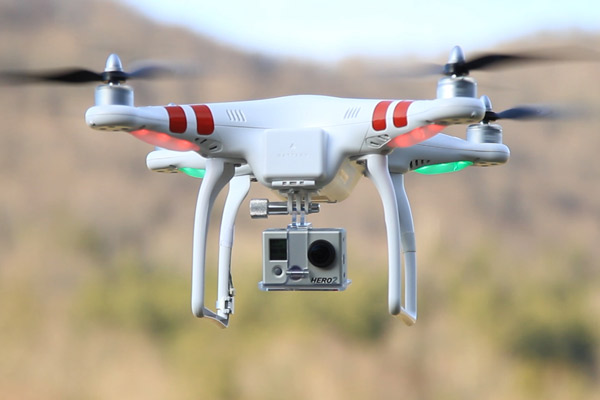
Swarm UAV drone and pilot prepare for takeoff
With the recent news that GoPro is planning the ‘launch’ of its own brand of drone, a rising trend in technology use that has the potential to soon reach fever pitch.
As their popularity continues to soar, drone regulation and restrictions will naturally need to be reviewed – hopefully prior to a serious accident occurring.
Since August this year, unmanned aerial vehicles (UAVs, commonly known as drones) such as the renowned DJI Phantom, have been banned from flying in US national parks.
Issued in June, the ban was introduced as a means to prevent drones from annoying park visitors, startling wildlife and threatening safety in general.
The stance has been endorsed by conservationists, sportspeople and adventurers alike expressing fears that the small, remote-controlled flying machines would not only cause undue and potentially fatal stress to any number of species, they may also put the lives of climbers and mountaineers in danger.
US park service’s director Jonathan Jarvis told The Associated Press that parks should have the power to confiscate these aircraft in order to prevent problems arising.
“This is a different kind of aircraft, and it is being used in different ways than what we have seen from the (model aircraft) hobbyists,” he said. “We want to have some control over it now before it proliferates.”
Dragging our heels
In Australia, the period for public submissions on a proposal Civil Aviation Safety Authority (CASA) to de-regulate drones less than two kilograms expired some time ago, while an ongoing review of drone regulation may continue for the next 12 months or more.
During an interview with Wild, CASA spokesperson Peter Gibson explained no decision had been made as yet, but that his organisation feels it’s important to keep the regulations up-to-date.
“We have something like 180 commercial operators approved in Australia and that number’s growing,” he said. “It’s a vibrant, growing sector of the aviation community and they’re working in all kinds of commercial and public service settings.
“On the recreation side, we may not know how many operators are out there due to the current lack of restrictions, but we know that these numbers are growing quickly also.”
Australia was one of the first country’s to introduce regulations in this niche sector of aviation law in 2002, and Gibson said this is the reason why a review has become necessary.
“We’re currently doing everything we can to ensure that operators, both commercial and recreational, understand the law as it applies to their use. We even ensure retailers and one manufacturer include a brochure that outlines these regulations with each unit they ship.”
These laws are mostly focused on requiring operators to keep drones away from the public, as they represent both a safety and privacy concern – but they do not yet include any mention of wildlife or responsible use in nature.
Flying by the rules
Ryan Hamlet, general manager of aerial photography business Swarm UAV, believes that CASA’s restrictions and communication with drone operators is relatively sound – but a little common sense should also be applied.
“CASA’s rules should be respected and followed, and generally I’d say that they are,” he said. “Keeping your aircraft 30 metres away from any people, keeping below 400 feet as well as keeping you drone within clear line of sight are all straightforward regulations that everyone can abide by.”
However, when intending to fly over or film any privately held or protected area, it pays to seek permission first, regardless of a lack of restrictions.
“Respect the other people using the space, as drones can be noisy and not everyone will be comfortable if you have a camera attachment,” Hamlet explained.
As a commercial operator, Swarm UAV ensures its pilots are also aware of any wildlife in an area they visit, and Hamlet said this is simply an extension of the company’s ethos when it comes to respecting other individuals in the environment in which the drones are flying.
“There’s plenty of footage online of bird strikes that cause damage to equipment as well as sometimes fatal injuries to the birds. As a business we have to be conscious of our impacts, but I suppose there’s a concern that, without stricter regulation, there’s not much to stop hobbyists from doing the wrong thing.”
The launch of the new GoPro drone is expected well ahead of any decision CASA may make regarding the responsible use of these aircraft.
Perhaps the question isn’t whether or not they should be banned from national parks, but how much damage will they cause in the intervening time?
UPDATES
Recently a spokesperson from the Northern Territory’s Parks and Wildlife office got back to us with some insights into how the parks authorities are dealing with UAVs at the moment.
The spokesperson said: “The Parks and Wildlife Commission is currently finalising policy on the use of drones.”
“There are CASA rules about the use of drones, but from the PWCNT perspective they are classified as aircraft as defined in our Act. We therefore require all operators to be issued a permit before they are allowed to land and/or take off within any park. This permit will take into account where it is permissible to launch, land and fly, as well as how this should be done correctly while avoiding proximity with other park users.”
Meanwhile, a spokesperson providing information on behalf of parks in New South Wales provided a slightly different response.
“People using UAV/RPAS commercially in NSW national parks and reserves are required to comply with Commonwealth and State regulations,” they said, while anyone filming for commercial reasons in these areas must also seek approval according to general film and photography guidelines.
Interestingly, it appears that the authorities in NSW do not currently have any restrictions in place for non-commercial usages of drones within parks and reserves.
Other state park authorities have been contacted for comment.


